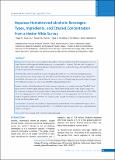Please use this identifier to cite or link to this item:
https://hdl.handle.net/20.500.14356/1765| Title: | Nepalese Homebrewed Alcoholic Beverages: Types, Ingredients, and Ethanol Concentration from a Nation Wide Survey |
| Citation: | Thapa N, Aryal KK, Paudel M, Puri R, Thapa P, Shrestha S, Shrestha S, Stray-Pedersen B. Nepalese Homebrewed Alcoholic Beverages: Types, Ingredients, and Ethanol Concentration from a Nation Wide Survey. J Nepal Health Res Counc. 2015 Jan-Apr;13(29):59-65. PMID: 26411715. |
| Issue Date: | 2015 |
| Publisher: | Nepal Health Research Council |
| Article Type: | Original Article |
| Keywords: | Cross-sectional study Home brewed alcohol Nepal |
| Series/Report no.: | Jan-April, 2015; |
| Abstract: | Abstract Background: Despite the enormous public health problems related to traditional alcohol consumption practice in Nepal, this area has been ignored and the information at the national level is limited. Thus this study is designed to explore the readily available commonly practiced Nepalese homebrewed alcoholic beverages, the ingredients used and alcohol strength (ethanol concentration). Methods: This study was carried out as a part of ongoing household survey on "Alcohol consumption practice among married women of reproductive age in Nepal". A total of 284 homebrewed alcoholic beverage (distilled 175, non-distilled:109) samples were collected from the 16 survey districts of Nepal during the period of April to August, 2013. Ethanol percentage was tested in research lab by using standard procedure. Results: Readily available homebrewed alcoholic beverages in practice were mainly of two types "Distilled" (local Raksi) and "Non-distilled" (Jand, Chhyang, Tumba). Rice, wheat, barley, millet, maize, fruits, and pure sugar were the commonly used ingredients to prepare alcohol. Ethanol concentration in homebrewed alcohol was 14.0% (IQR: 10.0-19.0) ranging from 3% to 40% for distilled, and 5.2% (IQR: 3.5-9.8) ranging from 1% to 18.9% for nondistilled. A significant difference (P<0.05) was found in alcohol strength by residence, development regions, types of alcohol, and the ingredients used. Conclusions: The median concentration of ethanol in readily available home brewed alcoholic beverages in Nepal was more than the strength of factory produced beer. The alcohol strength varies across their types, ingredients used, residence and regions. Keywords: Cross-sectional study; home brewed alcohol; nepal. |
| Description: | Original Article |
| URI: | http://103.69.126.140:8080/handle/20.500.14356/1765 |
| ISSN: | Print ISSN: 1727-5482; Online ISSN: 1999-6217 |
| Appears in Collections: | Vol. 13 No. 1 Issue 29 January - April 2015 |
Files in This Item:
| File | Description | Size | Format | |
|---|---|---|---|---|
| 59_65.pdf | Fulltext Download | 230.66 kB | Adobe PDF |  View/Open |
Items in DSpace are protected by copyright, with all rights reserved, unless otherwise indicated.
